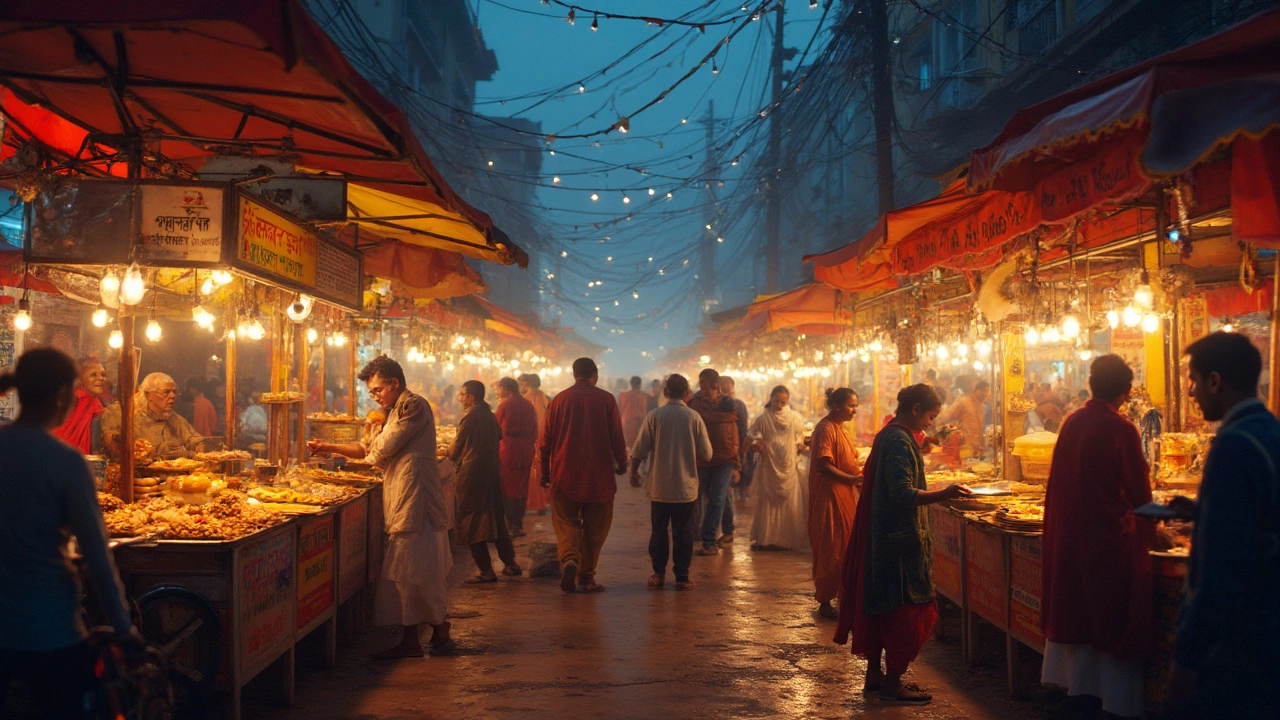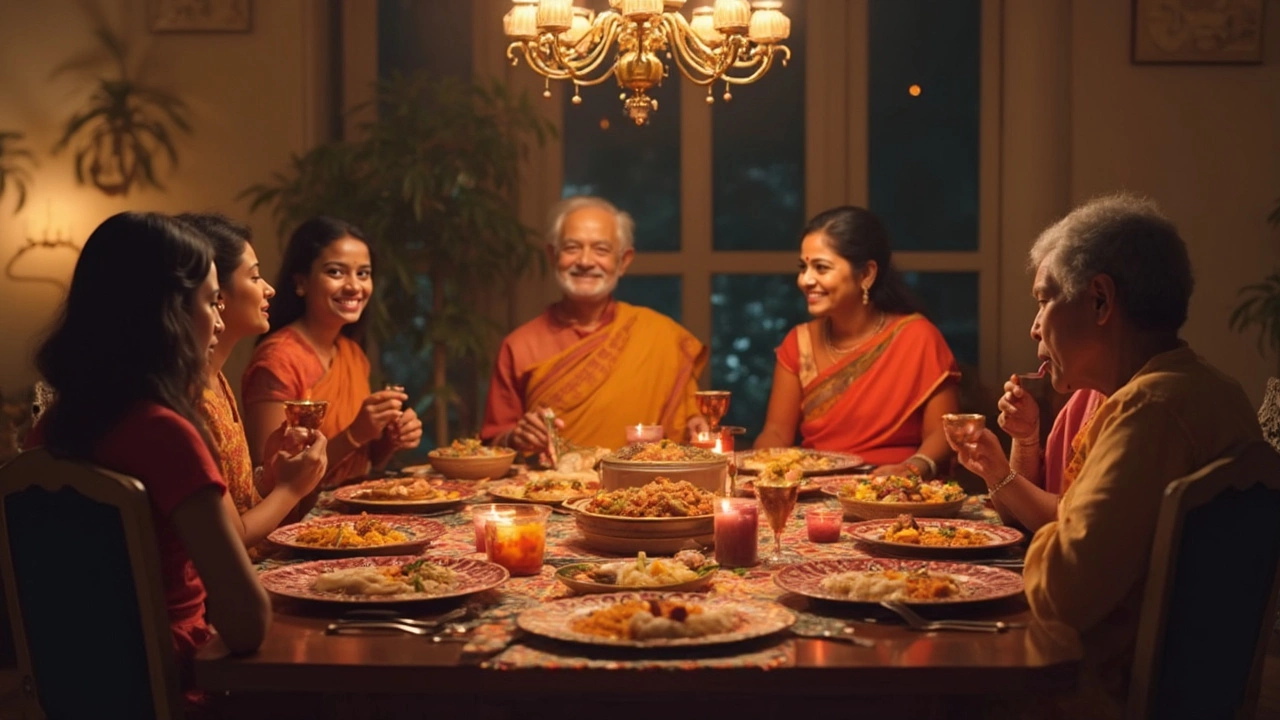When Do People in India Enjoy Dinner?
 Feb, 25 2025
Feb, 25 2025
So, what time do people actually sit down for dinner in India? Well, there's no one-size-fits-all answer here. The timing often swings wildly, depending on where you are and who you ask. In bustling cities like Mumbai and Delhi, you'll find folks grabbing a bite anywhere from 8 PM to as late as 10 PM. But head south, and in places like Tamil Nadu, it's not unusual to see plates of idlis and dosas being served much earlier.
Rural areas tend to see an earlier dinner time, around 7 PM, as life starts with the crack of dawn. But it’s the street food culture that shakes things up a bit. These vibrant food stalls stay busy till late, offering everything from spicy chaats to crunchy samosas, pushing dinner time to a more flexible schedule.
- Regional Dinner Times
- Urban vs. Rural Eating Habits
- Impact of Street Food
- Cultural Influence on Meal Timing
- Flexible Eating Schedules
- Conclusion: A Blend of Traditions
Regional Dinner Times
India is a big country with different meal times depending on where you are. In the north, for instance, it’s not unusual for families to sit down for dinner as late as 10 PM. This tendency is especially visible in bustling urban centers like Delhi and Mumbai. Life in these cities is fast-paced, impacting when people grab their evening meal, often influenced by work schedules.
In contrast, down south in Tamil Nadu and Kerala, people might eat dinner a bit earlier, usually around 7 PM to 8 PM. These regions still maintain some traditional ways, where meals are seen as an important part of daily life.
"The diversity of India's dinner times reflects its cultural richness. It's not about the clock, but rather how life flows in different parts of the country," says culinary expert Anita Kohli.
In the eastern states like West Bengal, meals are usually served later in the evening. Having a family meal between 8 PM and 9 PM is common. Meanwhile, across the western state of Gujarat, evenings are vibrant with street food markets, sometimes replacing traditional dinner time with snacks from 7 PM onwards.
Factors Affecting Dinner Times
The variations come down to lifestyle, cultural norms, and sometimes the weather. In hotter places, like Rajasthan, earlier dinners can help beat the heat, while in the north, colder weather might lead to later meals. Festivals and regional holidays also influence timing, with meals often adjusted around religious practices and celebrations.
Of course, street food plays a substantial role, especially with the younger crowd and working professionals who might prefer a quick bite on their way home rather than a sit-down meal.
| Region | Typical Dinner Time |
|---|---|
| North India | 8 PM - 10 PM |
| South India | 7 PM - 8 PM |
| East India | 8 PM - 9 PM |
| West India (Street Food Influence) | 7 PM onwards |
This diverse range of dinner times not only highlights how varied Indian culture is but also shows how it adapts to accommodate busy modern living while preserving time-honored traditions.
Urban vs. Rural Eating Habits
Dinner time in India reflects a stark difference when you compare urban to rural settings. In cities like Mumbai, Delhi, and Bangalore, the hustle and bustle of urban life means dinner can start later in the evening, often driven by the fast-paced, demanding work schedules. Folks here might sit down for dinner anywhere between 8 PM to 10 PM, juggling office hours, commutes, and late-night socializing before finally hitting the dinner table.
On the other hand, rural India's dinner schedule aligns more closely with the rising and setting of the sun. Most people in countryside areas tend to eat earlier, usually around 7 PM. The lifestyle here is driven more by agricultural activities, with early mornings and early evenings being the norm. This schedule allows them to make the most of daylight hours, crucial for farming activities.
Street Food's Role in Urban Areas
Street food is a big deal in urban centers. It offers quick, affordable meals on the go, which is why many urbanites might grab an early evening snack roadside before heading home for a late dinner. Street food stalls, with their vibrant flavors, offer an inexpensive way to grab a bite and often keep buzzing until late at night, especially during festivals or special events.
Impact of Technology
Another interesting twist is technology. With food delivery apps booming, urban dwellers now have the luxury to eat at their own pace. This means someone could order a pizza at 11 PM just as easily as having their traditional homemade meal.
| Setting | Typical Dinner Time |
|---|---|
| Urban | 8 PM - 10 PM |
| Rural | 6 PM - 8 PM |
It’s fascinating how large the gap can be between urban and rural when it comes to something as simple as dinner time. But whether you're dining under city lights or the stars of a rural village, food remains a central and joyous part of Indian life.
Impact of Street Food
India’s street food India scene is not just vibrant, it's a living, breathing party on the sidewalks. It influences when, what, and how we eat. Imagine the aromas of crispy pakoras and tangy pani puri wafting through the air. Can you resist? Probably not, which is why these stalls draw huge crowds, especially during the evening rush.
One crucial factor is convenience. Street food is quick and often the easiest way to grab a fulfilling meal without the hassle of cooking. This convenience means people can eat whenever they're hungry, rather than being tied to a strict mealtime routine. So, if you're roaming the streets of Mumbai or Delhi late at night, don't be surprised to see people munching away well past traditional dinner hours.
Street Food as a Social Hub
Street food isn't just about food; it’s a social experience. These stalls become gathering spots where folks from different walks of life converge. It’s common to see friends, families, and colleagues catching up, turning what was a simple meal into a shared experience. This social element often delays dinner time, as the focus is more on enjoying the moment than on the clock.
Cultural Fusion and Diversity
The variety offered by India's street food is like nowhere else. From spicy, savory to sweet, there’s something to please every palate. This diversity pulls people out of their homes to explore and enjoy food as an adventure. Plus, the influence of different cultures, from North Indian parathas to South Indian dosas, is reflected in stalls, promoting a mixed and flexible eating culture that doesn't always fit the traditional dinner timeframe.
In fact, a recent survey found that nearly 60% of urban Indians enjoy eating street food at least once a week. This indicates a strong inclination towards an evening ritual that’s not just about eating but experiencing the rich tapestry of flavors and social interactions.
All in all, the impact of street food is undeniable—it reshapes our eating habits, extends dinner time into the night, and makes meals a communal affair. It's not just food, it’s an essential part of cultural life and is a testament to India’s dynamic culinary scene.

Cultural Influence on Meal Timing
The time people eat dinner in India isn't just about hunger or convenience—it's deeply tied to cultural customs and practices. Take North India, for instance. Here, the influence of religious activities can shape when families sit down to their evening meals. Many Hindu households observe evening prayer rituals, known as 'Sandhya Aarti,' which often take place around sunset, nudging dinner time a little later.
Family structure also impacts dining hours. In joint families, common in parts of India, dinner is usually a significant event with all members gathering to eat together. This collective dining is not only about enjoying a meal but is a deliberate ritual that can influence when dinner is served.
In traditional South Indian culture, meals are often organized around the climate, which can affect dinner timing. The hotter the region, the later the dinner might be to take advantage of cooler evening temperatures.
Festivals and Special Occasions
Special occasions and festivals add another layer to dinner timing. During festivals like Diwali or Eid, the evening meal may be postponed to accommodate celebrations and integral religious observances. Think about it—waiting for the family to break their fast together during Ramadan can mean eating later than usual compared to a regular day.
These cultural nuances demonstrate how diverse and layered the concept of Indian dinner time can be. What's fascinating is how such practices show the flexibility and adaptability of Indian meal habits, reflecting a blend of tradition, necessity, and modern influence.
Flexible Eating Schedules
When talking about Indian dinner time, it's fascinating to observe just how flexible and adaptable it can be. Unlike many Western countries where dinner is often eaten around the same time every day, India’s dining patterns are influenced by a whirlwind of factors. Work hours, especially in urban areas, can run late, pushing dinner to 9 PM or even later.
One primary driver of this flexibility is the diverse nature of Indian work culture. Tech cities like Bangalore and Hyderabad see professionals heading out for dinner once they wrap up work, which can fluctuate based on meetings or project deadlines.
Impact of Street Food on Timing
Street food in India is a game-changer for dinner times. The bustling street markets, active from early evening till midnight, cater to different palates at different hours. It's not uncommon for people to grab a quick plate of pani puri for a pre-dinner snack around 6 PM and then head for a hearty dinner an hour or so later.
- Work schedules often dictate meal times, especially in metro cities.
- Street vendors and their vibrant offerings contribute to flexible dinner schedules.
- Social gatherings and festivities can shift traditional dinner times to much later in the evening.
Social and Cultural Events
Dinner times also stretch or contract based on social gatherings. Weddings, festivals, or even just a casual get-together with friends might see you having dinner at an unusual hour. Cultural events often follow a timeline that could push meals to after sunset, especially during festivals like Diwali or Navratri.
So, while other places might have rigid meals, in India, eating time is as dynamic as its streets. Whether you're munching late-night biryani in Hyderabad or having an early dosa dinner in Chennai, flexibility is key. And that’s what makes India's dining culture so captivating.
Conclusion: A Blend of Traditions
India is a land of rich cultural diversity, and its meals, especially dinner, reflect this. Whether it's the early dinners in some rural areas or the late-night meals in buzzing urban centers, Indian dinner time varies significantly across the country. But no matter where, food acts as a central part of daily life, with family dinners and social gatherings playing key roles.
One important aspect of Indian dining is the influence of street food. These convenient options allow people to eat on the go, often shifting the time when major meals like dinner occur. Street food adds a layer of flexibility and dynamism to eating habits.
So, the next time you're in India, don't be surprised if you find yourself enjoying a meal at 9 PM with street food accompanying your experience. It's a reflection of a society that blends tradition with modern lifestyles. From spicy chaats to hearty meals, India's eating patterns demonstrate how this country cherishes both its heritage and its vibrant present.